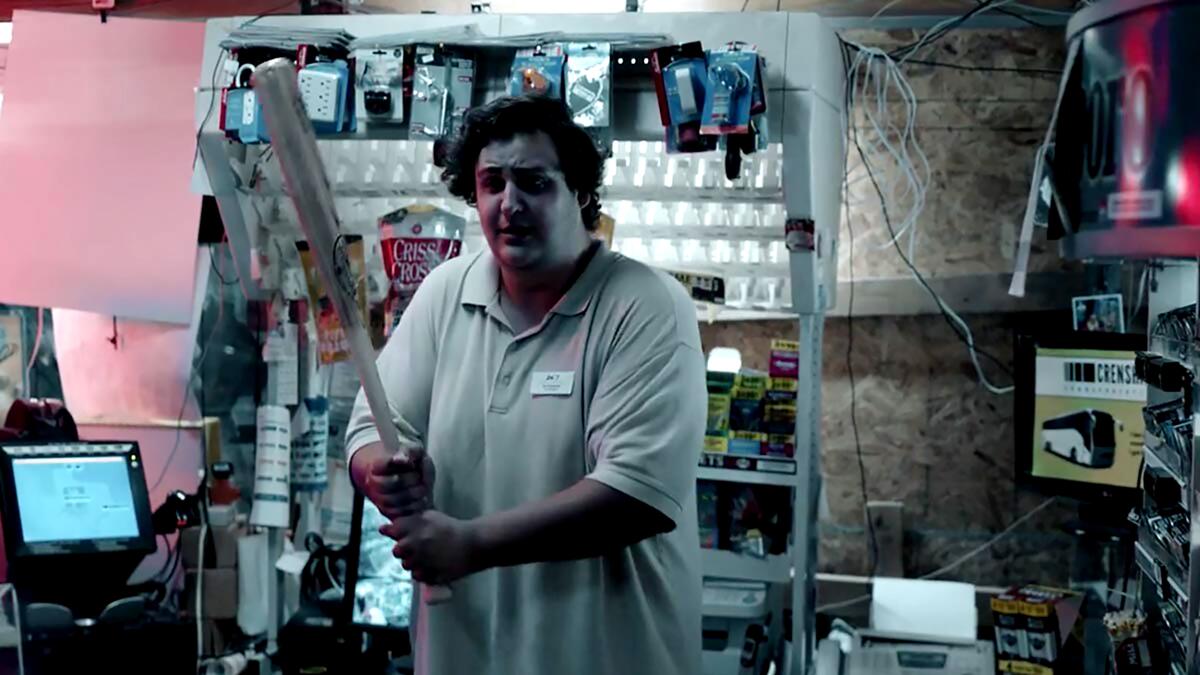Short films used to all but disappear after the festivals. Now they’re a click away

- Share via
Given 16 minutes of your life to spend watching a short film, would you click on one described on YouTube as “a homeless 7-year-old who lives on the beach makes and sells ‘stick people’ to get by”?
More than 25 million people answered that question with a “yes.” And while “Jada” may be the breakout star of the YouTube-based short-film platform Omeleto, it is by no means the most-watched short available on a streaming service.
When it comes to the high-profile side of the movie industry, short films tend to be on the low end of things. Poised somewhere between a “director advertisement” and an “expensive experiment,” short films rarely seem designed for mass appeal. But thanks to accessibility with over-the-top and free ad-supported streaming television platforms and services, that needle for shorts is quietly being moved.
Six years ago, “Jada’s” success took director Doug Roland by such surprise he considered it a “career-defining moment” when Omeleto, which was founded by Allen Tsai, plucked his heartfelt, heartbreaking project out of the post-film festival circuit obscurity it was destined for — and created a logline to help attract audiences.
“The first couple of days it went pretty well, and then I got a message from Allen and he’s like, ‘Your film is getting 100,000 views per hour,’” Roland says. “I’d made this film for $1,000, and it’s a slow-moving character study of a little girl. Definitely not something I thought would go viral.”
Once, the average movie lover had to attend film festivals to catch most shorts — or wait for the Oscar nominees to get a theatrical release as a group — but now platforms dedicated to such works are expanding. Over the last 15 years, channels such as Short of the Week, ShortsTV, Vimeo, Alter and Dust (the last two owned by studio Gunpowder & Sky) and Omeleto have embraced short films. Omeleto posts one new short per day; Alter and Dust share new content about once or twice a week. And while Omeleto’s “Jada” is that platform’s most-watched film with 25 million views, it pales in comparison to Dust’s top-rated — “The Promise” at a combined 55 million from their YouTube and Facebook sites — and Alter’s No. 1 — “Stucco” with a combined 75 million.
At a time when theatrical feature film attendance continues to plummet — in 2021, Gallup reported that the mean number of films an American adult saw at a theater each year was 1.4, a number depressed by the pandemic shutdowns but one that hasn’t yet rebounded — the success of bite-sized movies may come as a surprise. After all, their calling card nature hasn’t usually been aimed at general audiences.
“Short films were either an avenue for experimentation for an established filmmaker to have fun and tell a meandering tale or a teaser that keeps people wanting more,” says Clare Cooney, a filmmaker and Omeleto senior programmer. “You can do both. It’s more satisfying for the audience to see a complete story.” And many of those stories come with recognizable names in lead roles — Steven Yeun, Phoebe Waller-Bridge and Amanda Seyfried among them.
Finding that sweet spot is what Omeleto and its like-minded services have been aiming to do, with their individual methods of determining what audiences will want. Some are more scientific than others. Tsai, based in Taipei, Taiwan, is a numbers guy who doesn’t watch a lot of films, but loves to play with YouTube’s algorithm to entice viewers to his channel.

Take the title: On Omeleto, shorts lead not with the film’s actual title, but an SEO-friendly logline. It’s a choice that can rankle filmmakers, but Tsai insists that testing proves a title with an active, present-tense voice and subject-verb-object construction helps viewers decide if the film is for them.
“To succeed, you have to think from the perspective of the platform,” says Tsai via email. “The viewer makes a snap decision whether to click and watch based on the thumbnail and title. There’s an art and a science to it.” Other tests — such as determining which thumbnail image will cause more people to click through, and how engaged the audience appears to be, are part of Omeleto’s service to filmmakers.
To some, this sounds like trying to game the system. “There are certain things you can do with thumbnails to just get clicks, which we’re not interested in,” says Floris Bauer, co-founder and president of Gunpowder & Sky. “Omeleto is taking more of an approach that the filmmaker is less visible. We’re more filmmaker-centric. We’re trying to create a brand that’s meaningful in storytelling — not about surmising how to get clicks.”
Fede Goldenberg, global head of TV & film partnerships at YouTube, says that paying attention to algorithm sensitivity is important, but that’s not the only factor that matters. “You wouldn’t have 25 million views [on ‘Jada’] if it wasn’t good,” he says. “Yes, the algorithm rewards longer sessions. The title is just good at getting people to click. But the quality gets them to stay and watch through the whole thing.”
And while each of these services is free to the consumer, money is a sticking point for filmmakers. Making short films is expensive for filmmakers, and remuneration is either nominal or nonexistent.
“It’s hard to make money on short films in North America,” says Justin Giddings, a filmmaker and co-founder of Film Festival Mastery. “There’s not really a physical market for them. Traditionally, film festivals have given short films the hope of prestige, the collecting of laurels and networking. But [sites like] Omeleto are endpoints of distribution. What [streaming sites] offer is an audience. Until these distributor curators existed, most short films would die in obscurity after the festivals.”
But distributor-curators aren’t philanthropists; they’re businesses with their own expenses and profit margins, even when they are kindly disposed to creator challenges. So they charge for submissions: Omeleto, $80; Short of the Week, $30; Alter and Dust, $15. Fees to submit make logical sense: They’re quick money, but also provide a higher quality of submissions.

Not every submitted film is accepted onto any given platform, and outlets like Omeleto also pick up shorts from referrals, from distributors who want to generate buzz as part of an awards campaign or through the festival circuits. Criteria for what makes it through the process varies depending on the platform, but Omeleto wants films that will have a longer-than-average view duration and high engagement rate (i.e. comments left on YouTube).
“We’ll run tests [on films] and if the bounce rate [of viewers clicking out of the film] is high, we’ll suggest to filmmakers to make cuts to get to the story sooner,” says Tsai. “YouTube interprets a high bounce rate as a sign of viewer dissatisfaction — and won’t push a film far.”
Testing and packaging the film for its final appearance on the platform is what Tsai says is Omeleto’s contribution to the film’s success: “We’re actually most like a viral/digital marketing agency,” he adds. “Making a film is hard. Getting it seen is just as hard, if not harder.”
Short of the Week co-founder Jason Sondhi agrees that submission fees are a good gatekeeper toward increasing the quality of films received. “We offered free submissions for a short period of time, but when you offer something for free you get a huge, overwhelming volume,” he says. “Not only did [setting a fee] allow us to pay our writers and curators, it meant the quality of submissions was higher.” (Sites sometimes have dedicated submissions portals, but many use FilmFreeway to assist with funneling potential films to different platforms.)
Yet few filmmakers who make it through that gatekeeping see any compensation later. While several platforms have made efforts at revenue sharing via YouTube over the years, the sheer volume of payouts, plus the fact that many filmmakers (or, in the case of Tsai, channel owners) are outside the United States, as well as other complicating factors, means that filmmakers rarely see a dime no matter how well their film performs. (Alter and Dust pay their chosen filmmakers small sums; Giddings says he was offered $1,000 from Dust for one of his films.)
The new series from L.A. Times Studios is presenting five short documentaries on topics including the environment, social justice, homelessness and immigration available to stream for Times subscribers
But the platforms emphasize that they provide more than just a home for the film. They’re often behind creating savvy critical analysis and reviews to accompany each short, for example. “It’s not like we just throw a film up online and hope for the best,” says Omeleto head of programming Kat Ascharya. “We take a lot of care in choosing it and writing about it, and even after it’s released we watch it closely.”
And some filmmakers have managed to hook Hollywood: co-directors Ryan Polly and Matt Black are near to closing a deal for a feature film version of their Omeleto-based short “Monitor.” But generally, says Black, money “is the thing that always leaves.”
“We have yet to receive any money from a short film,” adds Polly. “Ad revenue goes to Omeleto, and we get eyes on the project — that’s totally fine. We can now say that Omeleto kick-started our career.”
So far, no one has really figured out the best way to monetize the system in a way that pays filmmakers and the outlets that showcase their works effectively. “There was a big conversation maybe five, 10 years ago where it was like, ‘When are you going to make a subscription VOD service that bundles these films together like a Netflix of short films,’” recalls Sondhi. “I never thought it was tenable.”
Still, creators and programmers of these platforms do seem to have pure intentions. Tsai himself may be in it primarily to play with the numbers, but there’s an overall appreciation of the short for what it is. Finding a way to make it not just a half-formed calling card, but one that stands up as a legitimate viewing experience for general audiences, would be a welcome evolution based on the viewer numbers.
“Our biggest asset is becoming a home for the next generation of great filmmakers,” Tsai says. “Omeleto has become a talent discovery engine. The next [Steven] Spielberg or [George] Lucas won’t be discovered through film festivals. They’ll be discovered online — hopefully through us.”
But that assumes there’s an economic and creative ecosystem that supports the creation of more short films with more than just exposure and critical reviews. “The way you nurture quality content is for there to be sustainability,” says Film Festival Mastery’s Giddings. “It won’t be sustainable if there isn’t a fair share of profits going to the artists actually creating it. None of these platforms will have good content if creators can’t take part in the financial profits.”
More to Read
Only good movies
Get the Indie Focus newsletter, Mark Olsen's weekly guide to the world of cinema.
You may occasionally receive promotional content from the Los Angeles Times.











